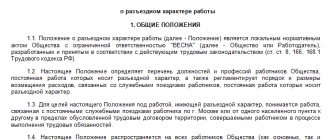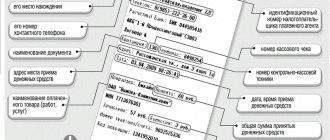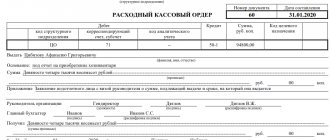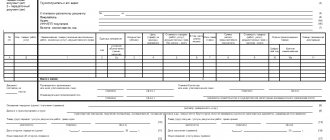Required details
The number of mandatory check details is quite large - about 30 items, and the legislator is constantly adding to this list.
The content of cash receipt data (cash receipt details) is determined by two main documents:
- Federal Law-54 dated 05/22/03
- by order of the Federal Tax Service No. ММВ-7-20/ [email protected] dated 21/03/17
They list the main details of a cash receipt, the form of their presentation, and the type. The order of arrangement of details on a check is not established by law.
Typically, information is arranged compactly, in separate parts, in accordance with the logic and content of the data:
- Data about the seller-owner of the cash register - in this part of the cash register receipt the name of the legal entity, its Taxpayer Identification Number or similar individual entrepreneur data is given.
- CCP data: its reg. number in the Federal Tax Service, serial number of the fiscal drive model. This block usually includes the address, place of payment - the address of the cash register and the name of the store, or the name and address of the company's trading website on the Internet, if we are talking about an online store.
- Check details. In addition to the name of the document, this includes the date and time when the check was punched through the cash register, the shift number, and the check number within this shift. Next, indicate the number in order of the fiscal document. Here the machine counts not only receipts, but also all fiscal documentation stored in the memory of the fiscal drive. Be sure to indicate the tax system. The cash register can be configured for several tax regimes, but you cannot indicate several transactions under different tax regimes in one check. In addition, the website address is indicated for the buyer to check the data, the fiscal sign of the document is a control value confirming the correctness of the entered data, the seller’s e-mail, from which he will send electronic checks at the buyer’s request.
- Information about the cashier: his full name, position, TIN, if available. If trading occurs without a seller (via the Internet or special trading devices), the details do not apply.
- Data about the product (work, service). The price, quantity, amount, and name of the subject of payment are indicated here. Discounts, markups, and VAT tax rates are also indicated here. If an advance was paid, the name is not indicated. The name and quantity are also not indicated by individual entrepreneurs who use any NO system, except OSNO, and who are not involved in the sale of excisable products (until 1/02/2021). Indicate the country of origin and TD number (for imported goods), if the calculation involves not an individual, but a legal entity and (or) individual entrepreneur.
- Product code. Despite the fact that this detail is mandatory (Regulation No. 174 of 02/21/19), it is not contained in every cash receipt. The details are required for use only in the case of the sale of goods subject to mandatory labeling in accordance with the legislation of the Russian Federation. Example: tobacco products. From 1/07/2019, labeling codes are applied to each pack; until 1/07/2020, the bulk of unlabeled tobacco products released earlier must be sold. For some types, sale without labeling is possible until 01/07/2021 (Regulation No. 224 of 02/28/19).
- Sales data. The method of payment is also indicated - cash or non-cash, the amount paid, the nature of the calculation - income, expense, return of income, expense. The amount of VAT is taken into account, if there is an OSNO - for each product separately. If the check amount is paid partly in cash and partly by non-cash money, this is also indicated. If the goods are excisable, indicate the excise tax.
- Buyer information. The buyer has the right to request an electronic check, then his e-mail and phone number must be included in the document. A similar situation can arise when shopping online. For legal entities and individual entrepreneurs, it is necessary to include the name (full name) and TIN in the document.
- QR code. Convenient for instantly reading information from a receipt.
Some of the check details, for example, the fiscal sign of the message (FPS), are not indicated in the check. This props is generated by tech. means and is assigned to the checks stored in the fiscal drive, which are then transferred to the OFD.
By the way! The more complex the format of fiscal data, the more information a cash register can generate in a check. Starting with format 1.05, you can indicate information about the subject of the transaction: goods, work, service, winnings, etc., payment method: for example, advance payment, full payment, prepayment.
Issuing a cash receipt
The cash receipt must be legible. It is printed on a special ribbon. For each individual entrepreneur and type of cash register, its own settings are created, which include the basic details of the fiscal document.
In addition, there is additional information that can be printed on the check. Basically it is placed at the top of the document. It contains a greeting to the client, gratitude for choosing a retail outlet, the latest news, promotional offers or other similar information.
The name of the organization, namely individual entrepreneur, on the check can be supplemented with information with the address or telephone number of the entrepreneur. This is permitted at the request of the device owner. The main body of this fiscal document specifies the type of operation:
- sale;
- return;
- reversal and others.
This block also contains the name of the product units, their quantity and cost. The sales products section ends with a final line where information about the total amount, payment and delivery is entered. Also, after these points, the cashier’s personal identification number, date and time of purchase are written down.
The last part basically always shows the registration data of the individual entrepreneur, the serial number of the check machine, and the fiscal regime.
Receipt parameters are configured for each cash register. If failures occur during the operation and some details of this fiscal document are displayed poorly or are missing, then it is necessary to suspend the activity until the correct operation of the cash register is established.
How are fiscal data deciphered in a check?
The meaning of most details is intuitive to the buyer, but the part related to fiscal data requires explanation. Let's take a closer look at some of the details of a cash receipt and their meaning.
Let us recall that fiscal data, according to Federal Law-54, is information about the payments of the seller and the buyer, stored in the fiscal memory and transmitted via online cash register to the Federal Tax Service, as well as information about the cash register equipment servicing these calculations:
- RN KKT - registration number of cash register equipment. It is assigned upon registration with the Federal Tax Service.
- ZN KKT - serial number of cash register equipment. This detail is entered at the equipment setup stage.
- FN No. - number of the fiscal drive (factory). It is entered into the settings before the cash register starts operating. Displayed automatically.
- FD No. - number of the fiscal receipt in order. It is assigned by the cash register automatically.
- FP, FPD - a fiscal sign of a document. It is affixed on the basis of the registration data of the trading organization in the Federal Tax Service: TIN, registration date, reg. CCP number, serial number of CCP; TIN OFD (fiscal data operator), in addition - the serial number of the FD.
- OFD website address, website address for checking the FPD, website address of the Federal Tax Service. At this address, the legality of the trade transaction is checked, which is recorded through the fiscal data operator, i.e. the check is checked. As a rule, the website of the tax service is indicated here.
- QR is a two-dimensional code. Designed to verify encoded check details, quickly read by image processing devices configured accordingly. The Federal Tax Service has developed a special program that works with a QR code.
For an electronic check the following are required:
- FDF version number - there are currently two versions of the fiscal data format in use: 1.05 and 1.1.
- FFD code is the code of the fiscal document form. For a check this is number 3, for a corrective cash receipt it is 31.
Cash register receipt: the main document for the operation
For several years now, there has been a norm in the country that establishes the mandatory presence of a cash register for all business entities. After each transaction of selling goods, the individual entrepreneur must issue a cash receipt. It is this document that confirms open activity. On its basis, the cash discipline of individual entrepreneurs is checked, as well as compliance with all fiscal norms established by the legislation of the Russian Federation. For a failed cash receipt, the entrepreneur is expected to be punished in the form of a fine.
The check issued by
the cash register is a fiscal document that is printed on a special tape and must have a set of
mandatory details . The latter include:
- name of the individual entrepreneur according to registration documents;
- taxpayer identification number - individual entrepreneur;
- serial number that was assigned to the cash register at the manufacturer;
- serial number;
- date of purchase;
- time of the transaction shown on the receipt;
- price of purchase or service provided;
- type of fiscal regime.
All these parameters can be indicated on this fiscal document during issuance in any order. That is, there is no single structure for a cash register receipt. The main thing is that the required details are indicated.
Additional details
In addition to the above, the owner of the cash register can additionally display any correct information in the cash receipt. Federal Law-54 does not contain any restrictions in this regard.
Most often, the additional block of a cash receipt includes:
- company advertisement, text and/or graphic;
- information about special offers, promotions, drawings of valuable prizes;
- a link to an online resource where the buyer can obtain additional information about the company, products and promotions.
Placing additional details, as a rule, is justified economically - due to the large coverage of buyers by such advertising.
Kinds
There are two types of cash receipts: fiscal and non-fiscal. At first glance, we can say that the differences between them are minimal, since both of them are issued upon purchase, but still there is a slight difference:
- A fiscal receipt is a document that must be passed through the cash register, and it must contain:
- Document's name.
- Taxation system (TSS).
- The exact date and time of the purchase.
- Shift receipt number.
- Registration (RN) and serial number (ZN) of the cash register.
- Fiscal storage number.
- A list of purchased goods and services, with the indicated price and quantity.
- VAT rate for each product or service.
- Total purchase amount and type of payment (cash or non-cash).
- FULL NAME. seller.
- Sender's email address and tax service website address.
- Number of the fiscal document (FD) and fiscal attribute (FP).
- Quick response code for the electronic version of the check.
Name of the organization and its address with index, TIN.
An example of what a fiscal check looks like (with the fiscal sign of the document):
You can check the authenticity of the issued check on the website https://check.ofd.ru or in the mobile application “Checking a Cashier’s Receipt”.
They are legal only if the seller applies UTII (Unified Tax on Imputed Income). Expenses certified by a non-fiscal document cannot be taken into account.
The main difference between the two checks is the presence of a fiscal sign, issued only by a cash register that has been registered with the tax office. All checks issued by him are stored in the fiscal memory of the device and the seller has no right to change or reset the contents of the cash register.
Fiscal checks should be transferred to the Federal Tax Service, but non-fiscal checks do not need to be transferred and are issued only to the buyer. The tax office carefully monitors the issuance of fiscal forms, because income tax is paid on all incoming cash.
Individual entrepreneurs and companies are required to provide fiscal receipts if they use the simplified or basic taxation system. They use the cash method, in which income and expenses are recognized only after funds have left or been received into the cash register or current account. Therefore, in order to report on your activities, checks are needed.
If the sale of a product or service was made without issuing a fiscal receipt, then on the basis of Part 6 of Art. 14.5 of the Code of Administrative Offenses of the Russian Federation, a legal entity is charged a fine in the amount of 5 to 10 thousand rubles or a warning is issued. For an official, the fine amount is from 1.5 to 2 thousand rubles.
Fiscal sign of a document (FP or FPD) - what does it mean?
On a cash receipt you can find abbreviations such as:
- FD.
- FP.
- FN.
What it is?
- FD is a fiscal document. This is information presented in the form of a cash receipt, strict reporting form or similar in established formats.
- The fiscal sign of a document (FP or FPD) is a sequence consisting of 10 digits. A ten-digit cipher is generated using a special device - a fiscal drive (FN) and using a fiscal attribute key to control the authenticity of fiscal data.
- FN - fiscal drive - software and hardware encryption tool for data protection. It contains FP keys, ensures the formation of FPs, recording of fiscal data and their storage, checking FPs, decoding and recognizing FDs.
What are these papers?
The main fiscal documents include...
Cash
They are formed in accordance with the Federal Law “On the use of cash register equipment when making payments in the Russian Federation” dated May 22, 2003 No. 54 FZ.
They are issued in paper or electronic form, but at the same time, it is electronic payment data that is transmitted to the Federal Tax Service, because the check file is stored in the fiscal storage device.
There are two ways to transfer a check to the Federal Tax Service:
- The first is when an electronic check is sent to the tax office. Using the Internet, when interacting with a fiscal data operator, an electronic check is submitted to the Federal Tax Service. This means what the fiscalization procedure is. All owners of online cash registers must enter into an agreement with a fiscal data operator (FDO).
- The second is when the tax office is given access to the check file in the storage device. It is assumed that the Federal Tax Service itself calculates all the necessary data from the brought drive (letter of the Federal Tax Service of the Russian Federation dated February 16, 2018 No. AS-4-20 / [email protected] ). This method of data transfer is used if it is not possible to transfer it from the cash register.
Strict reporting forms
The use of strict reporting forms (SRF) is also regulated by Federal Law-54. The difference between such forms and cash receipts is insignificant, since the algorithm for their fiscalization does not differ.
The difference is that the BSO is issued only for the provision of services, while a cash receipt is issued for both the sale of goods and the provision of services. It is rational to use a strict reporting form in cases where a business entity fears that during an audit the tax inspector may classify its activities as sales.
Even if the entity is really engaged only in the provision of services, it will be difficult to prove the opposite and the taxation system will have to be changed.
Commodity
The sales receipt is drawn up in accordance with the recommendations of the Ministry of Finance (letters dated 08/16/2017 No. 03-01-15/52653 and dated 05/06/2015 No. 03-11-06/2/26028. It is less common, but previously it was used constantly as confirmation purchases Most often, confirmation is made using a cash receipt, but if for some reason a cash receipt cannot be issued, then a sales receipt will be issued instead.
For example, in December 2021, there was a massive failure of online cash registers and many of the largest stores could not use the cash register and, accordingly, issue a receipt of the required type, so they had to resort to sales receipts. They served as fiscal documents, and during the audit, the tax service had every right to ask for copies of them.
Regardless of whether cash registers are working or not, a sales receipt is a fiscal document, since it is issued in two copies, one of which is in the accounting department and may be required by the Federal Tax Service during an audit.
Short
- The information contained in the cash receipt, according to current legislation, must give the buyer a complete picture of the outlet, the product purchased, the expenses incurred and the seller serving him.
- In addition, the check data allows you to check the legality of a trade transaction using modern technologies and Internet resources, receive an electronic check by email online and print it at your discretion.
- The cash receipt also contains comprehensive fiscal data transmitted to the Federal Tax Service about the trade transaction and the equipment and company (OFD) servicing the information exchange with the fiscal authority.
- The law allows you to include in the cash register receipt any additional information that stimulates sales of the owner of the cash register system.
Checking cash register receipts
The check machine must be used by all individual entrepreneurs who use cash as a payment method. After each transaction, a cash receipt must be printed. The issuance of these fiscal documents is verified by the tax authorities. A fine will be imposed on a check that is not cleared.
Checking the issuance of fiscal documents has several types:
- regular - a scheduled audit according to a schedule previously drawn up by the tax authorities;
- shuttle – checking the issuance of cash receipts several times a day for the same individual entrepreneur;
- cross-checking is carried out by fiscal policy authorities from other regions;
- raid - a comprehensive check by several government agencies.
The main goals of such control actions of individual entrepreneurs are their compliance with the norms of legislative acts on cash registers and the preparation of relevant documentation, as well as the completeness of the receipt of revenue.
The inspection is carried out by observation, test purchases, and document review. All data obtained during control actions makes it possible to identify violations or their absence.
Requirements for details
The set of details for a specific fiscal is directly influenced by the document format being tried on (FFD 1.05 or 1.1), as well as the check format (electronic or paper). Any details of the document must be easily distinguishable and readable for at least six months from the date of issue (for paper format). It is permissible to supplement the details of the cash document to the user of the online cash register, depending on the characteristics of the field of activity in which cash transactions are carried out. In addition, there is a list of additional details that are indicated in the check issued to the company or individual entrepreneur. In general, Article 4.7 of Federal Law No. 54 specifies all the required details of a cash receipt and their designations. These requirements must be met. Otherwise, the violator will face administrative liability.
Rate how useful the information in the article was?
Contacts for contacting Taxcom
Like other companies in the trading industry, Taxcom has several different types of communications. You can use them as a client needing services or a buyer coming for clarification.
- To contact the technical department, use the number: 0;
- Online cash registers: 0;
- Technical support for general questions: 0 (800) 250 73 45;
- Official group on VKontakte: https://vk.com/taxcom;
- Official Facebook group: https://www.facebook.com/taxcom;
- Write to email address
If you want to receive a quick and detailed answer to your question, use the feedback form on the page https://taxcom.ru/tekhpodderzhka/. Under the line for entering a question, click on the “Write a letter” link. In the form that opens, enter the company identification number (if any), full name, phone number, and email. And create a text message. You should expect a response to the email address you provided in the form.










